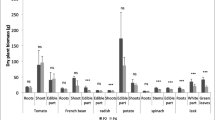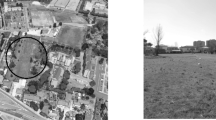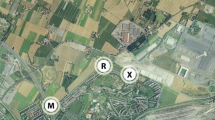Abstract
Lead (Pb) is commonly found in urban soils and can transfer to vegetables. This entails a health risk for consumers of garden crops. The increasing demand of gardening on urban soil linked to the population increase and concentration in urban areas induces an increase in the risk, as people could be forced to cultivate contaminated soils. The aim of this study was to evaluate the performance of a crop** system that allows simultaneously (i) growing eatable vegetables that accumulate few Pb and (ii) cleaning up the soil with other plants by phytoextraction. The tests were carried out in an allotment garden (Nantes, France) where soils are moderately enriched by Pb from geogenic origin (178 mg.kg−1 of dry soil on average). Four vegetables known to accumulate slightly Pb (Solanum lycopersicum, Brassica oleracea cv. “Capitata,” Solanum tuberosum, and Phaseolus vulgaris) were grown. The in situ ability of Brassica juncea L. to progressively absorb the phytoavailable Pb of the soil was assessed during four seasons. Analyses of the edible parts of the four vegetables confirmed that they can all be safely cultivated. The accumulation of Pb in B. juncea shoots was too low (ca. 1 mg.kg−1 of dry matter at best) for phytoextraction purposes. Our results confirm that it is possible to grow very low Pb-accumulating vegetables on soils moderately contaminated with Pb, although it was not possible to reduce phytoavailable Pb rapidly enough with B. juncea. This study identifies possible avenues of research to improve this crop** system by using appropriate vegetables that will allow food production to continue on moderately contaminated soil while cleaning it up.





Similar content being viewed by others
Data availability
The datasets generated during and/or analyzed during the current study are available from the corresponding author on reasonable request.
Code availability
Not applicable.
References
Antoniadis V, Levizou E, Shaheen SM, Ok YS, Sebastian A, Baum C, Prasad MNV, Wenzel WW, Rinklebe J (2017) Trace elements in the soil-plant interface: phytoavailability, translocation, and phytoremediation–a review. EARTH-SCI REV 171: https://doi.org/10.1016/j.earscirev.2017.06.005G
Augustsson A, Lundgren M, Qvarforth A, Hough R, Engström E, Paulukat C, Rodushkin I (2023) Managing health risks in urban agriculture: the effect of vegetable washing for reducing exposure to metal contaminants. Sci Total Environ 863:160996. https://doi.org/10.1016/j.scitotenv.2022.160996
Bassegio C, Campagnolo MA, Schwantes D, Gonçalves Junior AC, Manfrin J, Schiller ADP, Bassegio D (2020) Growth and accumulation of Pb by roots and shoots of Brassica juncea L. Int J Phytoremediat 22(2):134. https://doi.org/10.1080/15226514.2019.1647406
Bidar G, Pelfrêne A, Schwartz C, Waterlot C, Sahmer K, Marot F, Douay F (2020) Urban kitchen gardens: effect of the soil contamination and parameters on the trace element accumulation in vegetables–a review. Sci Total Environ 738:139569. https://doi.org/10.1016/j.scitotenv.2020.139569
Binner T, Sullivan MAK, Jansen MEM (2023) Metals in urban soils of Europe: a systematic review. Sci Total Environ 854:158734. https://doi.org/10.1016/j.scitotenv.2022.158734. (ISSN 0048-9697)
Bouquet D, Braud A, Lebeau T (2017) Brassica juncea tested on urban soils moderately contaminated by lead: origin of contamination and effect of chelates. Int J Phytoremediat 19(5):425. https://doi.org/10.1080/15226514.2016.1244160
Bouquet D, Lépinay A, Gaudin P, Jean-Soro L, Le Guern C, Lichtfouse E, Lebeau T (2020) A new assay of bacterial selection with Pb reveals an unexpected effect of Pb on bacterial behavior. Implications for remediation. Environ Chem Lett 18(3). https://doi.org/10.1007/s10311-020-00986-y
Bouzouidja R, Bouquet D, Pierart A, Shahid M, Le Guern C, Jean-Soro L, Dumat C, Lebeau T (2019) Metal contamination in urban soils: which managements using nature-based solution for the development of a safe urban crop**? In: Bioremediation of agricultural soils, CRC Press, pp. 87–108. https://doi.org/10.1201/9781315205137-5
Brown SL, Chaney RL, Hettiarachchi GM (2015) Lead in urban soils: a real or perceived concern for urban agriculture? J Environ Qual. https://doi.org/10.2134/jeq2015.07.0376
Clark HF, Hausladen DM, Brabander DJ (2008) Urbans gardens: lead exposure, recontamination mechanisms, and application for remediation design. Environ Res 107(3):312. https://doi.org/10.1016/j.envres.2008.03.003
Cundy AB, Bardos RP, Puschenreiter M, Mench M, Bert V, Friesl-Hanl W, Müller I, Li XN, Weyens N, Witters N, Vangronsveld J (2016) Brownfields to green fields: realising wider benefits from practical contaminant phytomanagement strategies. J Environ Manage 184:67. https://doi.org/10.1016/j.jenvman.2016.03.028
Gurajala HK, Cao X, Tang L, Ramesh TM, Lu M, Yang X (2019) Comparative assessment of Indian mustard (Brassica juncea L.) genotypes for phytoremediation of Cd and Pb contaminated soils. Environ Pollut 254. https://doi.org/10.1016/j.envpol.2019.113085
Hou Q, Wang W, Yang Y, Hu J, Bian C, ** L, et al. (2020) Rhizosphere microbial diversity and community dynamics during potato cultivation. Eur J Soil Biol 98. https://doi.org/10.1016/j.ejsobi.2020.103176
Hyman M, Dupont RR (2001) Groundwater and soil remediation: process design and cost estimating of proven technologies. American Society of Civil Engineers Press, Reston, VA, p 517
Jean-Soro L, Le Guern C, Béchet B, Lebeau T, Ringeard MF (2015) Origin of trace elements in an urban garden in Nantes. France J Soils Sediments 15:1802. https://doi.org/10.1007/s11368-014-0952-y
Joimel S, Cortet J, Jolivet CC, Sabyd NPA, Chenot ED, Branchue P, Consalès JN, Lefort C, Morel JL, Schwartz C (2016) Physico-chemical characteristics of topsoil for contrasted forest, agricultural, urban and industrial land uses in France. Sci Tot Environ 545:40. https://doi.org/10.1016/j.scitotenv.2015.12.035
Kandic S, Tepe SJ, Blanch EW, De Silva S, Mikkonen HG, Reichman SM (2019) Quantifying factors related to urban metal contamination in vegetable garden soils of the west and north of Melbourne. Australia Environ Pollut 251:193. https://doi.org/10.1016/j.envpol.2019.04.031
Kanwar VS, Sharma A, Srivastav AL, Rani L (2020) Phytoremediation of toxic metals present in soil and water environment: a critical review. Environ Sci Pollut Res 27:44835. https://doi.org/10.1007/s11356-020-10713-3
Kidd P, Mench M, Álvarez-Lópeza V, Bertc V, Dimitrioud I, Friesl-Hanle W, Herzigf R, Jansseng JO, Kolbasbh A, Mülleri I, Neui S, Renellaj G, Ruttensg A, Vangronsveldg J, Puschenreiterk M (2015) Agronomic practices for improving gentle remediation of trace element-contaminated soils. Int J Phytoremediat 17(11):1005. https://doi.org/10.1080/15226514.2014.1003788
Kumar PBAN, Dushenkov V, Motto H, Raskin Y (1995) Phytoextraction: the use of plants to remove heavy metals from soils. Environ Sci Technol 29:1232. https://doi.org/10.1021/es00005a014
Laffray X, Toulaïb K, Balland-Bolou-Bi C, Bagard M, Leitao L, Huguenot D, Alphonse V, Abbad-Andaloussi S, Livet A, Bousserrhin N, Leymarie J, Repellin A (2021) Evaluation of trace metal accumulation in six vegetable crops intercropped with phytostabilizing plant species, in a French urban wasteland. Environ Sci Pollut Res 28(40):56795. https://doi.org/10.1007/s11356-021-14512-2
Le Guern C, Jean-Soro L, Béchet B, Lebeau T, Bouquet D (2018) Management initiatives in support of the soil quality of urban allotment gardens: examples from Nantes (France). Land Degrad Dev 29:3681. https://doi.org/10.1002/ldr.3123
Lebeau T, Braud A, Jézéquel K (2008) Performance of bioaugmentation-assisted phytoextraction applied to metal contaminated soils: a review. Environ Pollut 153(3):497. https://doi.org/10.1016/j.envpol.2007.09.015
Liu L, Li W, Song W, Guo M (2018) Remediation techniques for heavy metal-contaminated soils: principles and applicability. Sci Tot Environ 633:206. https://doi.org/10.1016/j.scitotenv.2018.03.161
Ma L, Liu Y, Wu Y, Wang Q, Sahito ZA, Zhou Q, Huang LT, Feng Y (2021) The effects and health risk assessment of cauliflower co-crop** with Sedum alfredii in cadmium contaminated vegetable field. Environ Pollut 268:115869. https://doi.org/10.1016/j.envpol.2020.115869
Mahdieh M, Yazdani M, Mahdieh S (2013) The high potential of Pelargonium roseum plant for phytoremediation of heavy metals. Environ Monit Assess 185:7877. https://doi.org/10.1007/s10661-013-3141-3
McBride MB, Shayler HA, Spliethoff HM, Mitchell RG, Marquez-Bravo LG, Ferenz GS, Russell-Anelli JM, Casey L, Bachman S (2014) Concentrations of lead, cadmium and barium in urban garden-grown vegetables: the impact of soil variables. Environ Pollut 194:254. https://doi.org/10.1016/j.envpol.2014.07.036
Morel JL (1997) Bioavailability of trace elements to terrestrial plants. Soil ecotoxicology. Lewis Publishers, Boca Raton, United States, CRC, pp 141–175
Palmer S, McIlwaine R, Ofterdinger U, Cox SF, McKinley JM, Doherty R, Wragg J, Cave M (2015) The effects of lead sources on oral bioaccessibility in soil and implications for contaminated land risk management. Environ Pollut 198:161. https://doi.org/10.1016/j.envpol.2015.01.004
Rathore SS, Shekhawat K, Dass A, Kandpal BK, Singh VK (2019) Phytoremediation mechanism in Indian mustard (Brassica juncea) and its enhancement through agronomic interventions. Proc Natl Acad Sci, India, Sect B Biol Sci 89:419. https://doi.org/10.1007/s40011-017-0885-5
Reeves RD, Baker AJM, Jaffré T, Erskine PD, Echevarria G, van der Ent A (2018) A global database for plants that hyperaccumulate metal and metalloid trace elements. New Phytol 218:407. https://doi.org/10.1111/nph.14907
Schwartz C, Chenot ED, Douay F, Dumat C, Pernin C, Pourrut B (2013) Jardins potagers: terres inconnues ? EDP Sciences. https://doi.org/10.1051/978-2-7598-1037-6
Shahid M, Pinelli E, Dumat C (2012) Review of Pb availability and toxicity to plants in relation with metal speciation; role of synthetic and natural organic ligands. J Hazard Mater 219:1. https://doi.org/10.1016/j.jhazmat.2012.01.060
Szolnoki ZS, Farsang A, Puskás I (2013) Cumulative impacts of human activities on urban garden soils: origin and accumulation of metals. Environ Pollut 177:106. https://doi.org/10.1016/j.envpol.2013.02.007
Tang L, Hamid Y, Zehra A, Sahito ZA, He Z, Beri WT, Khan MB, Yang X (2020) Fava bean intercrop** with Sedum alfredii inoculated with endophytes enhances phytoremediation of cadmium and lead co-contaminated field. Environ Pollut 265:114861. https://doi.org/10.1016/j.envpol.2020.114861
Witters N, Mendelsohn R, Van Passel S, Van Slycken S, Weyens N, Schreurs E, Meers E, Tack F, Vanheusden B, Vangronsveld J (2012) Phytoremediation, a sustainable remediation technology? Biomass Bioenerg 39:470. https://doi.org/10.1016/j.biombioe.2011.08.016
Yu L, Zhu J, Huang Q, Su D, Jiang R, Li H (2014) Application of a rotation system to oilseed rape and rice fields in Cd-contaminated agricultural land to ensure food safety. Ecotox Environ Safe 108:287. https://doi.org/10.1016/j.ecoenv.2014.07.019
Acknowledgements
The authors would like to thank the POLLUSOLS program administered by OSUNA (UMS 3281 CNRS-Université de Nantes CNRS), the IRSTV Institute (FR 2488 CNRS), and the city of Nantes for their financial contribution to this research project. We are also grateful to the gardeners, from the Eglantiers garden, involved in this participatory experiment.
Funding
This study was funded by the Pays de la Loire region (POLLUSOLS project), the IRSTV Institute (FR 2488 CNRS), and the city of Nantes.
Author information
Authors and Affiliations
Contributions
All the authors contributed to the conception and design of the study. Material preparation, data collection, and analysis were performed by Dorine Bouquet, Alexandra Lépinay, and Pierre Gaudin. The first draft of the manuscript was written by Dorine Bouquet. Writing, reviewing, and editing were performed by Dorine Bouquet, Hervé Capiaux, Thierry Lebeau, Cécile Le Guern, Liliane Jean-Soro, and Alexandra Lépinay. All the authors read and approved the final manuscript.
Corresponding author
Ethics declarations
Ethics approval
Not applicable.
Consent to participate
Informed consent was obtained from all individual participants in the study.
Consent for publication
This does not apply to the content of this article.
Competing interests
The authors declare no competing interests.
Additional information
Responsible Editor: Roberto Terzano
Publisher's Note
Springer Nature remains neutral with regard to jurisdictional claims in published maps and institutional affiliations.
Supplementary Information
Rights and permissions
Springer Nature or its licensor (e.g. a society or other partner) holds exclusive rights to this article under a publishing agreement with the author(s) or other rightsholder(s); author self-archiving of the accepted manuscript version of this article is solely governed by the terms of such publishing agreement and applicable law.
About this article
Cite this article
Bouquet, D., Lépinay, A., Le Guern, C. et al. Maintaining the cultivation of vegetables with low Pb accumulation while remediating the soil of an allotment garden (Nantes, France) by phytoextraction. Environ Sci Pollut Res 31, 29374–29384 (2024). https://doi.org/10.1007/s11356-024-33104-4
Received:
Accepted:
Published:
Issue Date:
DOI: https://doi.org/10.1007/s11356-024-33104-4




